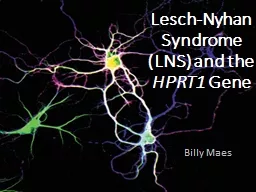

HPRT1 Gene Billy Maes What is LeschNyhan Syndrome Gouty arthritis Kidney stones Loss of motor control Cognitive problems Selfmutilation What is LeschNyhan Syndrome https youtube1U6LDpFLFEt58s ID: 779764
Download The PPT/PDF document "Lesch-Nyhan Syndrome (LNS) and the" is the property of its rightful owner. Permission is granted to download and print the materials on this web site for personal, non-commercial use only, and to display it on your personal computer provided you do not modify the materials and that you retain all copyright notices contained in the materials. By downloading content from our website, you accept the terms of this agreement.
Slide1
Lesch-Nyhan Syndrome (LNS) and the
HPRT1 Gene
Billy Maes
Slide2What is Lesch-Nyhan Syndrome?
Gouty arthritis
Kidney stones
Loss of motor control
Cognitive problems
Self-mutilation
Slide3What is Lesch-Nyhan Syndrome?
https://
youtu.be/1U6LDpF_LFE?t=58s
Slide4What causes Lesch-Nyhan Syndrome?
Excess uric acid
gout and kidney stones
**Unknown mechanism
neurological symptoms
Slide5>300 mutations in HPRT1 are known to cause LNSHPRT protein
Point mutations
Loss-of-function mutations
Change in size, shape
Slide6218 aa
214
Human
Mouse
Chicken
Zebrafish
Roundworm
Arabidopsis
Phosphoribosyl transferase domain
97%
91%
91%
49%
31%
218
218
188
218
% Identity
How well conserved is HPRT?
Slide7What are
HPRT1
’s GO terms?
Biological Processes
Molecular Functions
Cellular Components
Neuron development and differentiation
Purine Salvage Pathway
Dopamine metabolism
Dendrite morphogenesis
Locomotory
behavior
Nucleotide binding
Phosphribosyltransferase
activity
Magnesium
i
on binding
Cytoplasm
Slide8Dopamine
Pleasure
Reward motivation
Motor function
Compulsive behavior
**LNS phenotypes may be caused by abnormal brain development, induced by low dopamine levels
neonatally
Slide9Gap in Knowledge
Slide10HypothesisHypothesis: HPRT1 regulates the development of the dopaminergic system, important for normal cognition and behavior, through protein interactions in the brain.
Slide11Primary Goal
Primary Goal: Determine the genomic and proteomic changes that contribute to LNS neurological dysfunction as a result of loss-of-function mutations in HPRT1.
Slide12Zebrafish: A Model Organism for LNS
91% identity to human HPRT
Slide13Specific Aim #1: HPRT interaction partners
Affinity purification- mass spectrometry
(AP-MS)
STRING database
Determine function of HPRT interaction partners
Slide14Specific Aim #1: HPRT interaction partners
**Hypothesis: SQSTM1 activates NF-KB (synaptic plasticity & dendrite growth), NGF (nerve growth), and
titin
/TTN (linked to movement disorders)
Slide15Specific Aim #2: Altered Protein levels?
Quantitative mass spectrometry:
Compare protein levels in wild-type and HPRT-mutant zebrafish
**Hypothesis: SQSTM1 decreases in HPRT mutants
Slide16Specific Aim #3: Altered gene expression during brain development?
**This will indicate
when
mutations in
HPRT1
alter neuronal gene function, indicating how brain development may be altered
HPRT-mutant
DNA microarray of brain cells at each stage of development
Slide17Conclusions Future DirectionsAims: indicate how gene expression and protein interactions change as a result of HPRT mutations.
Gain insight into the mechanisms that lead to the neuronal-behavioral phenotypes of LNS.
Alter levels of SQSTM1 and other proteins that interact with HPRT1.
O
bserve if neurological or behavioral LNS phenotypes appear in mice.
Slide18Image URLs and Referenceshttp://
www.gnet.org/wp-content/uploads/explained-got-disease.jpghttp://www.keystonekidney.com/images/about-kidney-stones.gif
http://
simple-health-secrets.com/wp-content/uploads/2013/06/Lesch-Nyhan-Syndrome-4.jpg
http://
medicalpictures.net/wp-content/uploads/2010/10/Lesch-Nyhan-Syndrome-pictures-3.jpg
http://www.ojrd.com/content/2/1/48/figure/F1http://4.bp.blogspot.com/-IZrB3OKIHH8/Uo7dqy5kLSI/AAAAAAAAABA/2ahaXRkqelg/s72-c/leshnyhan.jpghttp://www.movementdisorders.org/MDS-Files1/Journals/Images/CPJ-Volume-1-Issue-3/mdc312040-fig-0001.png
http://
www.cdb.riken.jp/jp/04_news/annual_reports/2006/WebHelp/common/lab1_07hlfig2.htm
http://
drrajivdesaimd.com/wp-content/uploads/2013/06/dopamine-pathways.jpg
http://www.stats.ox.ac.uk/~
hamer/images/complex.png
http://
www.posturologiaclinica.net/img/rx_cranio_brain_02.jpg
http://
www.nature.com/nrm/journal/v8/n8/images/nrm2208-f1.jpg
http://transforming-science.com/wp-content/uploads/2013/12/Zebrafish-aquarium.-
010.jpg
http://
kimgen677s10.weebly.com/uploads/3/6/1/8/3618941/290277.jpg?325
http://
upload.wikimedia.org/wikipedia/en/thumb/c/c8/Microarray-schema.jpg/220px-Microarray-schema.jpg
https://
denisezannino.files.wordpress.com/2013/07/zebrafish-kimmel.jpg
http://
cdn.superbwallpapers.com/wallpapers/3d/mechanism-15796-1920x1200.jpg
Torres RJ and
Puig
JG. (2007). Hypoxanthine-guanine
phosophoribosyltransferase
(HPRT) deficiency: Lesch-Nyhan syndrome.
Orphanet
Journal of Rare Diseases, 2,
48. doi:10.1186/1750-1172-2-48Torres RJ,
Mateos FA, Molano J, Gathoff BS, O'Neill JP, Gundel RM, Trombley L, Puig JG. (2000). Molecular basis of hypoxanthine-guanine phosphoribosyltransferase deficiency in thirteen Spanish families. Hum Mutat,15,
383.Jinnah HA, De Gregorio L, Harris JC, Nyhan WL, O'Neill JP. (2000). The spectrum of inherited mutations causing HPRT deficiency: 75 new cases and a review of 196 previously reported cases.
Mutat Res, 463, 309-326.Breese GR, Criswell HE, Duncan GE, Mueller RA. (1990). A dopamine deficiency model of Lesch-Nyhan disease – the neonatal-6-OHDA-lesioned rat.
Brain Res Bull, 25, 477-484. DOI: 10.1016/0361-9230(90)90240-Z
Ernst M, Zametkin AJ, Matochik JA, Pascualvaca
D, Jons PH, Hardy C, Hankerson JG, Doudet DJ, Cohen RM. (1996). Presynaptic dopaminergic deficits in Lesch-Nyhan disease.
New Engl. J Med, 334, 1568-1572. DOI: 10.1056/NEJM199606133342403"Lesch-Nyhan syndrome". Genetics Home Reference. US National Library of Medicine, Feb. 2013. Web. 24 Jan. 2015.
"Lesch-Nyhan Syndrome". NYU Langone Medical Center. Aug. 2014. Web. 25 Jan. 2015
."Gout". Mayo Clinic. 25 Nov. 2014. Web. 24 Jan. 2015.
García PJ, Torres JR, Mateos F, Ramos T, Arcas J,
Buño A, O'Neill P. (2001). The spectrum of Hypoxanthine-Guanine Phosphoribosyltransferase (HPRT) deficiency. Clinical experience based on 22 patients from 18 Spanish families. Medicine (Balt
), 80, 102-112."Dystonias
Fact Sheet". National Institute of Neurological Disorders and Stroke. 12 Nov. 2014 Web. 24 Jan. 2015. Schretlen DJ, Harris JC, Park KS, Jinnah HA, del
Pozo NO. (2001). Neurocognitive functioning in Lesch-Nyhan disease and partial hypoxanthine-guanine phosphoribosyltransferase deficiency. J Int
Neuropsychol Soc, 7, 805-812.
Anderson LT, Ernst M. (1994). Self-injury in Lesch-Nyhan disease. J Autism Dev Disord, 24, 67-81
.Davidson BL, Tarle SA, Palella TD, Kelley WN. (1989). Molecular basis of hypoxanthine-guanine phosphoribosyltransferase deficiency in ten subjects determined by direct sequencing of amplified transcripts.
J Clin Invest, 84, 342-346.Olson L, Houlihan D. (2000). A review of behavioral treatments used for Lesch-Nyhan syndrome. Behav
Modif, 24, 202-222.Gene Ontology Consortium. An Introduction to the Gene Ontology
. Accessed 26 February 2015.Herron, J.C. and Freeman S. (2014). Evolutionary Analysis: Fifth Edition. Glenview, IL: Pearson Education, Inc.Delsuc F, Brinkmann H, Philippe H. (2005). Phylogenomics
and the reconstruction of the tree of life. Nat Rev Genet 6:361-375.About BLAST
http://www.ncbi.nlm.nih.gov/books/NBK1734/Gingras
AC,
Gstaiger
M,
Raught
B, and
Aebersold
R. (2007). Analysis of protein complexes using mass spectrometry.
Nat Rev
Mol
Cell
Biol
, 19
(4), 645-654.